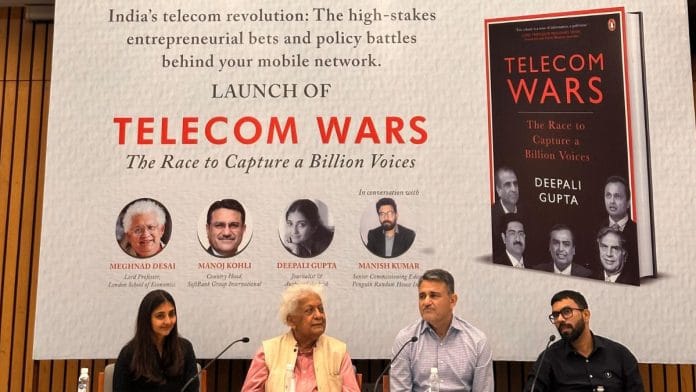New Delhi: No conversation on India’s telecom story is complete without the mention of the 2G scam. But journalist and author of Telecom Wars Deepali Gupta said that while it was a significant moment in regulatory history, it shouldn’t define the sector’s legacy.
“In my mind, the 2G scam is a parallel plot; not the main story,” Gupta said.
Gupta was speaking at the book launch at the India International Centre in Delhi. On the panel, the author was joined by Manoj Kohli, Country Head, SoftBank Group International and former MD & CEO, Airtel, Meghnad Desai, Professor, London School of Economics, and Manish Kumar, from Penguin Random House, who moderated the event.
Telecom Wars chronicles the last four decades of India’s telecom history—how the market grew from six million phone lines in 1990 to 1.2 billion mobile connections today. It captures what the author describes as the people-powered revolution, not as a eulogy to corporations, but as a testament to India’s adaptability, grit, and instinctive embrace of change.
The hour-long session was laced with personal stories from the speakers and anecdotes related to the sector.
On 2G, Gupta urged the audience to take a wider view. The story of India’s telecom rise is built not on a few high-profile names, but on the back of millions of unsung heroes, she said.
“There is no single person this book is about,” she said. ”It’s about the executives who kept towers running during floods. The call-centre agent who forgot to hit ‘record’ but got the job done anyway. The rural entrepreneur who turned data into a livelihood.”
Also read: Telecom biggies must get out of solo mode. Sharing infrastructure is crucial for growth
One recharge at a time
Two-thirds of Google Pay’s transaction volumes now come from Tier 3 towns and villages in India. This statistic alone paints a vivid picture of how deeply digital connectivity has penetrated India’s grassroots. Once dismissed as too remote or underdeveloped for tech adoption, rural India today is driving the digital economy forward.
Gupta elaborated on how telecom enabled productivity in the most unlikely corners: “A sabziwala could now take extra orders. His farm produce wouldn’t go to waste. That’s what connectivity achieved.”
What makes this change remarkable, the author pointed out, is how deeply intuitive Indian users proved to be. “You didn’t need to teach people. The convenience taught them. Whether in Bihar or Bengaluru, people figured out how to recharge, use the internet, or make calls; because it made life better.”
Manoj Kohli, with over 20 years of frontline experience, recounted the milestones and minefields of India’s telecom story—describing it as “the most critical evolution in modern India.”
He credited the early leadership shown by the government; particularly Prime Minister Vajpayee’s administration; for shifting the telecom policy from fixed licensing fees to a revenue-share model in the late 1990s. This single change opened the gates for investment and competition.
More recently, he pointed to how telecom emerged as the invisible hero during the Covid-19 pandemic. “What carried us through lockdowns? Telecom. While we stayed indoors, networks stayed on—working 24/7,” he said.
Today, with average monthly data consumption at 27 GB and voice usage hitting 1100–1200 minutes per user, India ranks among the highest consumers globally with the lowest tariffs.
(Edited by Theres Sudeep)






